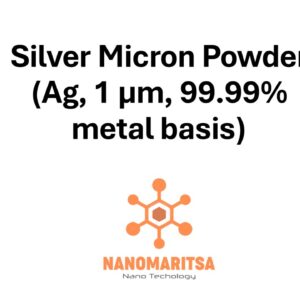Copper Micron Powder (Cu, 325 Mesh, Spherical, 99.9%) is a high-purity copper powder with a spherical shape and a fine particle size, passing through a 325 mesh sieve (approximately 44 micrometers). With a purity of 99.9%, this copper powder offers superior electrical and thermal conductivity, making it ideal for a wide range of applications that require precision, high performance, and consistent material properties. The spherical shape of the particles enhances their flowability and packing density, making it especially suitable for additive manufacturing, conductive coatings, and other specialized industrial processes.
1. Key Properties
- High Purity (99.9%): Ensures minimal contamination, maximizing conductivity and thermal efficiency in sensitive applications like electronics, energy systems, and catalysts.
- Spherical Shape: The spherical particle morphology improves flowability and ease of handling, which is crucial for powder-based manufacturing processes like 3D printing and coating applications.
- Particle Size (325 Mesh, ~44 µm): The fine particle size enhances surface area for improved chemical reactivity, effective dispersion, and optimal performance in various systems.
- Excellent Electrical and Thermal Conductivity: Copper is an outstanding conductor of electricity and heat, making this powder ideal for use in electronic and energy-related applications.
- Corrosion Resistance: Copper’s natural resistance to corrosion ensures the material remains stable and effective over extended periods, even in demanding environments.
2. Applications
- Additive Manufacturing (3D Printing): Used in metal 3D printing (powder bed fusion techniques), where spherical copper powder ensures high precision and quality in the production of complex parts with excellent thermal and electrical properties.
- Conductive Coatings: Incorporated into conductive inks and coatings for printed circuit boards (PCBs), flexible electronics, and other conductive material applications.
- Electronics Manufacturing: Applied in the production of electronic components, such as capacitors, resistors, and inductors, which require high conductivity and fine precision.
- Energy Storage Systems: Used in battery manufacturing, particularly in electrodes, to enhance conductivity and energy storage efficiency.
- Thermal Management: Incorporated into heat sinks, thermal pastes, and other components for efficient heat dissipation in electronics and power systems.
- Catalysis and Chemical Reactions: Copper micron powder is used as a catalyst or a catalyst support in chemical processes such as hydrogenation and other industrial applications.
3. Advantages
- Improved Flowability: The spherical shape of the particles provides excellent flow characteristics, reducing the risk of clogging in manufacturing processes like powder-based 3D printing.
- High Performance: Due to its high purity (99.9%), the powder exhibits optimal performance in conductivity and heat transfer, making it suitable for advanced electronics and energy systems.
- Enhanced Dispersion: The fine particle size ensures even distribution in composite materials, coatings, and pastes, ensuring consistent quality and performance in final products.
- Versatile Use: The material’s excellent properties make it suitable for a wide range of industries, from electronics to energy storage and advanced manufacturing.
- Corrosion Resistance and Longevity: Copper’s inherent resistance to corrosion ensures that the powder maintains its effectiveness over time, especially in harsh environments.
4. Recent Trends and Research
- Advanced Manufacturing Techniques: Spherical copper powder is gaining traction in 3D printing and additive manufacturing, where precise metal deposition is critical for producing high-quality metal parts for aerospace, automotive, and electronics industries.
- Energy-Efficient Electronics: The increasing demand for energy-efficient and thermally stable electronics is driving the use of copper micron powder in components like heat sinks, capacitors, and printed circuit boards (PCBs).
- Sustainability in Electronics: With a focus on eco-friendly production methods and recycling, research is ongoing to optimize the use of copper in green technologies, particularly in renewable energy systems and electric vehicles.
- Nanotechnology and Hybrid Composites: Copper powder is being incorporated into hybrid materials combined with other nanomaterials, like graphene, for enhanced conductivity and mechanical properties.
5. Future Prospects
Copper Micron Powder (Cu, 325 Mesh, Spherical, 99.9%) is set to play an essential role in next-generation manufacturing, electronics, and energy technologies. Future developments may include:
- High-Performance Energy Storage: Expanding applications in advanced battery technologies, such as lithium-ion and solid-state batteries, where copper’s conductivity enhances efficiency and energy density.
- Integration in Smart Electronics: Copper’s use in flexible and printed electronics is expected to grow, especially as wearable devices, flexible sensors, and IoT applications continue to advance.
- Advanced Thermal Management: Increased demand for efficient heat dissipation in high-performance computing, power electronics, and electric vehicles will drive the use of copper powder in heat management solutions.
- Sustainable Manufacturing: The development of more sustainable and efficient methods for producing and recycling copper powder will support the growing demand for eco-friendly electronic and energy technologies.
With its high purity, fine particle size, and spherical shape, Copper Micron Powder (Cu, 325 Mesh, Spherical, 99.9%) continues to be a key material in cutting-edge industries, offering high performance, precision, and versatility in various applications across electronics, energy, and manufacturing sectors. Its unique properties make it indispensable in the development of next-generation technologies.
| Measurement (gr) | 100 grams, 500 grams, 1000 grams |
|---|






